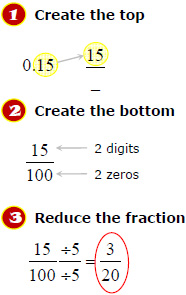
 |
|
|
|
Converting Decimal to FractionWhen you are converting decimal to fraction, remember these three easy steps:
Once you know the process for decimal to fraction conversion, GradeA has a nice shortcut for you: a free online decimal to fraction calculator. Don't use this unless you understand the process above first - but once you do, it will be a real time save for you!
In this example we are going to convert the decimal 0.15 into a fraction.
Description of each of the three steps above:
If you are having trouble with step 3, let GradeA help you reduce fractions.
GradeA offers plenty of other resources for converting between forms. You might like to:
Otherwise return from Converting Decimal to Fraction to Rules of Fractions.
|
| . | ||
| Home │ Site Search │ Math Help Blog │ Help Keep GradeA Free | |
Written by Team GradeAmathhelp.com, all rights reserved. | ||
